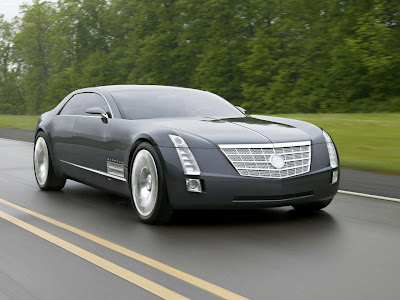




The Cadillac Sixteen was a prototype of a stylish and high performance automobile first presented by Cadillac in 2003.
The vehicle was equipped by a 32-valve V-16 concept engine displacing 13.6 liters and was mated to a four-speed electronically controlled automatic transmission. The engine featured fuel-saving Displacement on Demand technology, debuting in 2004 on some 2005 GM models, which shuts down half of the cylinders during most driving conditions and automatically and seamlessly reactivates them for more demanding conditions, such as brisk acceleration or load hauling when the driver needs the engine's full power. The engine was said to produce 1000 hp (750 kW) and 1000 ft·lbf (1350 N·m) of torque using no form of forced induction.
The car was conceptually related to the Cadillac V-16 of the 1930's. The actual design of the car was a combination of Cadillac's current "Art and Science" design theme and 1967 Cadillac Eldorado cues. Additional original design elements were provided by an in-house design competition led by GM Vice President Robert Lutz.
The Sixteen is also known to have the steering wheel logo carved out of solid crystal and a Bulgari clock on the dashboard.
Although the Sixteen fell short (narrowly, by some accounts) of production approval, its legacy is alive in Cadillac's future product planning. The next generation of Cadillac products is expected to incorporate elements of the Sixteen's design. These influences are expected to range from styling cues to a possible scaled-down version of the car, which may be powered by a V8 or V12. This range-topper, which has not been formally announced, is often referred to as the ULS (ultra luxury sedan) when GM executives talk with automotive media sources. If built, it would compete with the Mercedes-Benz S-Class and the BMW 7-Series. There are plans to introduce a car very similar to this in 2009. It will have a base V8, and the top model will have a V12.
The vehicle was equipped by a 32-valve V-16 concept engine displacing 13.6 liters and was mated to a four-speed electronically controlled automatic transmission. The engine featured fuel-saving Displacement on Demand technology, debuting in 2004 on some 2005 GM models, which shuts down half of the cylinders during most driving conditions and automatically and seamlessly reactivates them for more demanding conditions, such as brisk acceleration or load hauling when the driver needs the engine's full power. The engine was said to produce 1000 hp (750 kW) and 1000 ft·lbf (1350 N·m) of torque using no form of forced induction.
The car was conceptually related to the Cadillac V-16 of the 1930's. The actual design of the car was a combination of Cadillac's current "Art and Science" design theme and 1967 Cadillac Eldorado cues. Additional original design elements were provided by an in-house design competition led by GM Vice President Robert Lutz.
The Sixteen is also known to have the steering wheel logo carved out of solid crystal and a Bulgari clock on the dashboard.
Although the Sixteen fell short (narrowly, by some accounts) of production approval, its legacy is alive in Cadillac's future product planning. The next generation of Cadillac products is expected to incorporate elements of the Sixteen's design. These influences are expected to range from styling cues to a possible scaled-down version of the car, which may be powered by a V8 or V12. This range-topper, which has not been formally announced, is often referred to as the ULS (ultra luxury sedan) when GM executives talk with automotive media sources. If built, it would compete with the Mercedes-Benz S-Class and the BMW 7-Series. There are plans to introduce a car very similar to this in 2009. It will have a base V8, and the top model will have a V12.